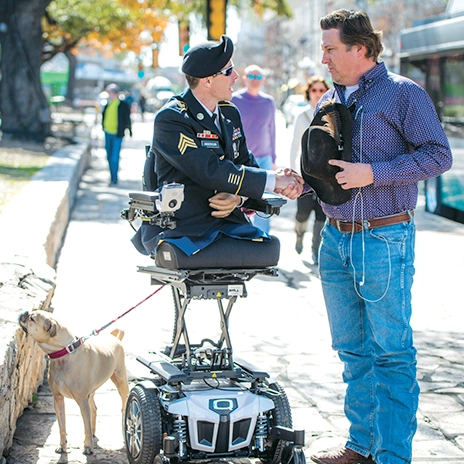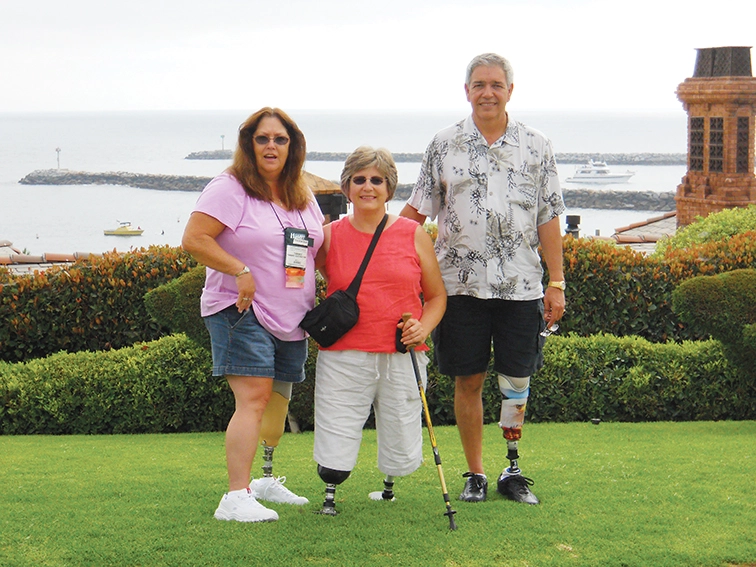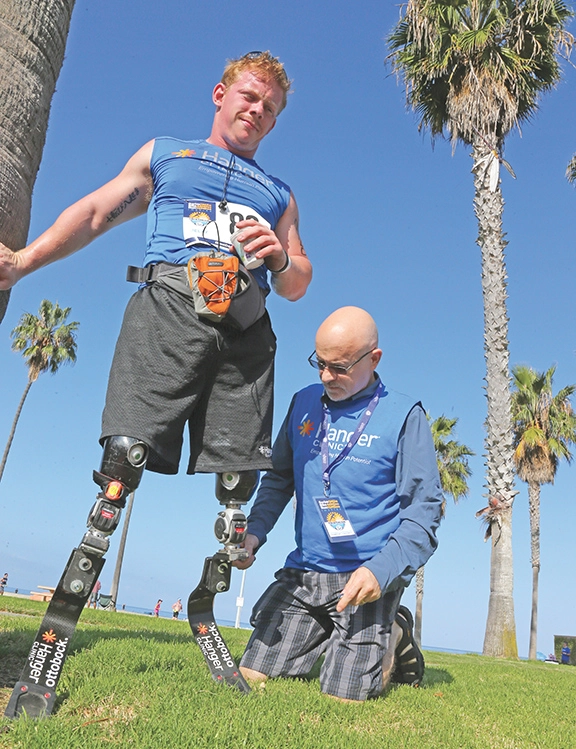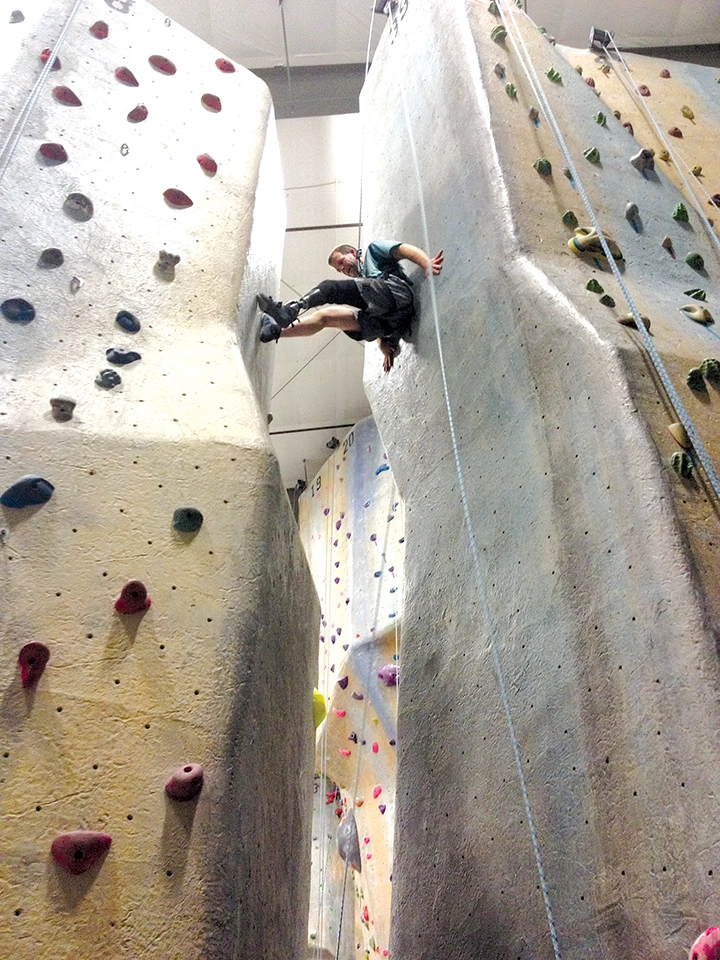By Élan Young
Using Multiple Assistive Devices to Keep Moving

Image courtesy of Quantum Rehab.
When someone becomes an amputee, he or she will need to figure out how to become mobile again. Chief on many amputees’ minds is concern about how they will perform regular, everyday activities again, not to mention whether or not they’ll be able to engage in activities that require endurance or speed. With the assistance of various mobility devices, many of these individuals can function at a similar or sometimes even greater level than before. An integral part of making the transition to a successful post-amputation life is finding the assistive devices that fit one’s body and lifestyle.
Many factors go into choosing mobility aids, and a team of healthcare professionals can help make the available choices clearer. Kevin Carroll, MS, CP, FAAOP/D, vice president of prosthetics for Hanger Clinic, says that every patient is different. “Everyone has a different level of energy, motivation, and drive,” he says. “We not only have to figure out how motivated they are initially, we also have to get them the tools to be successful ambulators.” In his extensive experience working as a certified prosthetist, he says the good news is that he’s seen a great many patients do well with prostheses.
Not everyone realizes how many people might be involved in getting a single amputee moving again. The most successful patients are the ones who have a partnership with a physical therapist, occupational therapist, prosthetist, and physiatrist. “What we’ve found is that the patients who go into therapy have superior outcomes,” says Carroll.
Technology also plays a big role in helping patients become mobile again. For lower-limb amputees, socket fit advancements have greatly improved the wearability of prosthetic devices. There are now soft gels to protect the limb, sleeves, and vacuum systems. For those who want more from a foot system, there are hydraulic ankle systems or microprocessor ankle systems.

Carroll says that many people turn to the Internet to get an idea of what devices they want to use. “Patients sometimes come in with a lot of information,” he says. “Part of our role is ensuring that the patient has a good grasp of what will and won’t work for them. Not everything on the Internet will be a good fit, but it is important for many patients to work with a prosthetist who is open to new technologies.”
Stella Sieber is a 61-year-old bilateral above-knee amputee who lost her legs in 2001 due to trauma and chooses to use foreshortened prostheses, or “platforms” as she calls them. This decision was based on making her life easier and helping her conserve energy throughout the day. With an 18-year career at the National Institute of Environmental Health Sciences, she was already busy. Add in community volunteerism and outdoor recreation, and it was clear that Sieber needed a device that would help her maintain an activity level vital to her long-term health and well-being. However, the choice to use foreshortened prostheses came after some initial trial and error.
“My choice to try using them was to see if I could walk better, longer, and with more stability than in the C-Legs,” she says. While attending the Amputee Coalition conference in 2004, she saw a demonstration of foreshortened prostheses for the first time. After returning home, she met with her prosthetist and shared her photos and observations from the conference. This led to the realization that the sockets she had been wearing for three and half years were too small. “He measured, made new sockets that I am still wearing today, and attached foreshortened prostheses to the bottoms,” she recalls. “I stood up, walked out, and shy of days when I have skin or other issues, I walk all the time.”

Image courtesy of Hanger Clinic.
Some may not like foreshortened prostheses because they don’t allow users to wear shoes or stand at their natural height. But for Sieber these drawbacks don’t outweigh her ability to be independent and active. She’s still enjoying a lifestyle that allows her to travel and garden while working full-time—and she has never fallen when using her foreshortened prostheses.
Bryan Anderson, an Iraq War veteran who lost his legs above the knees and his left hand in an improvised explosive device (IED) blast in 2005, was struggling to wear prostheses after his 13-month recovery at Walter Reed, Washington DC. Each leg has just a few inches remaining, which means he has little power or control when using prostheses. Bone spurs and the fact that his legs were thin, which makes a comfortable socket fit difficult, resulted in a significant struggle to find comfort and balance.
In 2008, after being spotted on the cover of Esquire magazine, Anderson was approached by Quantum Rehab®, a division of Pride Mobility and a maker of specialty power chairs, to be the company’s spokesperson. From the beginning, Quantum Rehab wanted his input for designing a chair that he and other injured soldiers would want to use. With input from Anderson and other users, the company designed the new iLevel® Power Chair that can power up to eye level and travel more quickly than previous models. The chair makes daily life from a power chair more natural overall because the users can integrate into their surroundings. Additionally, the chair allows for easy passage over rugged terrain so users don’t have to stick to paved paths. Lastly, users reported that its design features and being able to quickly elevate to eye level means using a wheelchair carries less of a stigma and allows the chair to become more of a conversation piece.
For Anderson, the choice to use an elevating wheelchair, rather than a traditional chair, is not just about finding a solution that avoids the discomfort of his prosthetic legs. For him, it’s about being more relatable to others because he’s meeting them at eye level. “People don’t shy away from you as much,” he says about interactions he has while using the iLevel. “When you’re up on the same level, they are more open to talk to you.” With this new chair and opportunities like appearing in American Sniper and serving as an ambassador for the Gary Sinise Foundation, Anderson is definitely back in the saddle and enjoying being able to help others. “The worst thing that happened to me ended up being the best thing,” he says. “You can come out of this and live the life you want to live by living by example.”

Image courtesy of Darryl Partridge.
Darryl Partridge is another amputee whose device choices helped him achieve his mobility goals. When he injured his talus, one of the small bones in his ankle, it set him on a course of pain, multiple surgeries, and even a job loss. As doctors tried to save his ankle, Partridge went through six surgeries in four years, but in the end he had his leg amputated. Although he primarily uses a prosthesis, he used crutches while he was waiting for his prosthetic leg. Even today, he doesn’t limit himself to using only a prosthesis. He feels versatile with crutches, which also serve to give his leg a rest from the prosthesis.
Before the injury, Partridge was a busy schoolteacher, husband, and father of three young children. He was busy in the way that any working parent is, but he was not working out in a traditional sense. “I had never been to the gym and had no intentions of going to the gym,” he says of that time in his life. After it became clear that he would need to have the amputation to regain his mobility, he did start going to the gym. However, it was after his amputation that he really got serious.
The morning after his amputation, he told the nurses that he wanted to walk. They came in with a wheelchair, and he refused. By this time, he was used to using crutches to help him walk, and he convinced them to let him try. Because he’d already mourned the loss of his leg, the amputation was more of a relief and enabled him to achieve a level of mobility he hadn’t had in years.
Only five months post-amputation, he hired a trainer and began TRX training, which is a suspension system that uses gravity and a person’s body weight for resistance. He hopped around on one leg and told the trainer to push him as hard as possible. “I discovered that I didn’t have phantom pain when I was at the gym,” he says.
He was hooked. Partridge became a personal trainer 14 months after his amputation, and today he’s a mentor to other amputees through his website and blog, www.lifebeyond4limbs.com. “My wife considers me the most able person she knows,” he says. Since his life was changed by the injury, he’s now more active than ever, and not just in the gym. “I ski, climb rock walls, bike, and live my life with no limits,” he says. His willingness to also use crutches has allowed him to keep his body fit and active while motivating others to do the same. “The message I want to get out to amputees is that this doesn’t end your life by any means,” he says. “If you have the desire, you can get out and do whatever you want.”
People with limb loss have to decide what kind of devices they will use to regain basic mobility and push beyond perceived limits. Some might choose to use a prosthesis part time or full time, while others might choose to use crutches, a wheelchair, a power chair, a scooter, a walker, or one of the many other types of devices available. Others might choose to use a combination of devices.
Even beyond deciding on a device type, there are a variety of choices within the broader category, such as the choice between underarm, forearm, or ergonomic crutches. Therefore, for the best outcomes, it’s important to talk to one’s healthcare providers about the available options and their pros and cons.
Although amputees share much in common, the choice of mobility devices is highly individualized and should not be based only on perceptions of how they look but also how they function and feel. The main goal is that they should fit well without causing additional pain or injury.
While the quest for mobility can often be daunting, with a little experimentation and the choice of the right mobility devices for one’s unique situation and personal goals, it is possible to find success.



